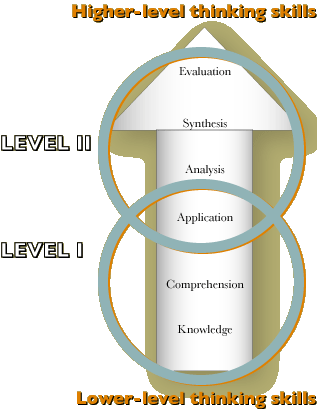
|
 |
 |
TOPICS
A. Bloom's Taxonomy
B. Writing Selected Response Assessment Items
C. Item Analysis
 |
||
A. Bloom's TaxonomyQuestions (items) on quizzes and exams can demand different levels of thinking skills. For example, some questions might be simple memorization of facts, and others might require the ability to synthesize information from several sources to select or construct a response. Benjamin Bloom created a hierarchy of cognitive skills (called Bloom's taxonomy) that is often used to categorize the levels of cognitive involvement (thinking skills) in educational settings. The taxonomy provides a good structure to assist teachers in writing objectives and assessments. It can be divided into two levels -- Level I (the lower level) contains knowledge, comprehension and application; Level II (the higher level) includes application, analysis, synthesis, and evaluation (see the diagram below).
Figure 1. Bloom's Taxonomy. Bloom's taxonomy is also used to guide the development of standardized assessments. For example, in Florida, about 65% of the questions on the statewide reading test (FCAT) are designed to measure Level II thinking skills (application, analysis, synthesis, and evaluation). To prepare students for these standardized tests, classroom assessments must also demand both Level I and II thinking skills. Integrating higher level skills into instruction and assessment increases the likelihood that students will succeed on tests and become better problem solvers.
|
||
 |
||
Try This
|
|
Continue
to Section B This course was developed in partnership between the Pinellas School District and the Florida Center for Instructional Technology at USF. |


